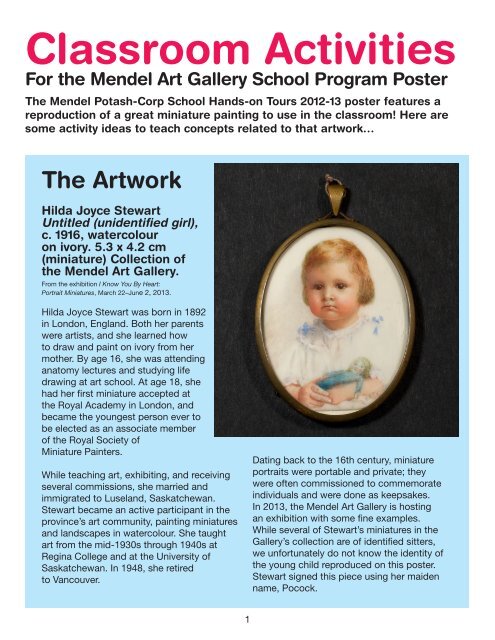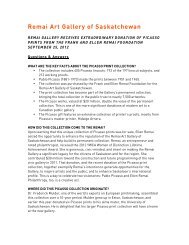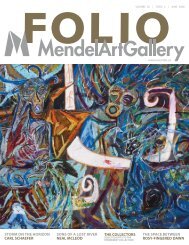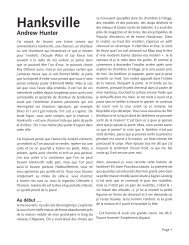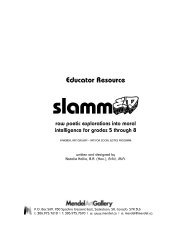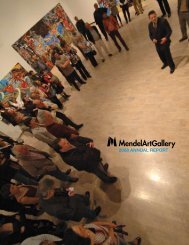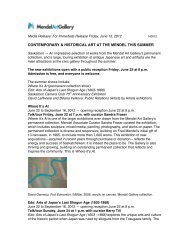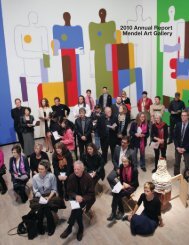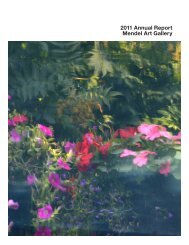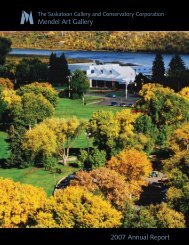Classroom Activities - Mendel Art Gallery
Classroom Activities - Mendel Art Gallery
Classroom Activities - Mendel Art Gallery
- No tags were found...
You also want an ePaper? Increase the reach of your titles
YUMPU automatically turns print PDFs into web optimized ePapers that Google loves.
<strong>Classroom</strong> <strong>Activities</strong>For the <strong>Mendel</strong> <strong>Art</strong> <strong>Gallery</strong> School Program PosterThe <strong>Mendel</strong> Potash-Corp School Hands-on Tours 2012-13 poster features areproduction of a great miniature painting to use in the classroom! Here aresome activity ideas to teach concepts related to that artwork…The <strong>Art</strong>workHilda Joyce StewartUntitled (unidentified girl),c. 1916, watercolouron ivory. 5.3 x 4.2 cm(miniature) Collection ofthe <strong>Mendel</strong> <strong>Art</strong> <strong>Gallery</strong>.From the exhibition I Know You By Heart:Portrait Miniatures, March 22–June 2, 2013.Hilda Joyce Stewart was born in 1892in London, England. Both her parentswere artists, and she learned howto draw and paint on ivory from hermother. By age 16, she was attendinganatomy lectures and studying lifedrawing at art school. At age 18, shehad her first miniature accepted atthe Royal Academy in London, andbecame the youngest person ever tobe elected as an associate memberof the Royal Society ofMiniature Painters.While teaching art, exhibiting, and receivingseveral commissions, she married andimmigrated to Luseland, Saskatchewan.Stewart became an active participant in theprovince’s art community, painting miniaturesand landscapes in watercolour. She taughtart from the mid-1930s through 1940s atRegina College and at the University ofSaskatchewan. In 1948, she retiredto Vancouver.Dating back to the 16th century, miniatureportraits were portable and private; theywere often commissioned to commemorateindividuals and were done as keepsakes.In 2013, the <strong>Mendel</strong> <strong>Art</strong> <strong>Gallery</strong> is hostingan exhibition with some fine examples.While several of Stewart’s miniatures in the<strong>Gallery</strong>’s collection are of identified sitters,we unfortunately do not know the identity ofthe young child reproduced on this poster.Stewart signed this piece using her maidenname, Pocock.1
Activity SuggestionsMiniature paintings are part of the tradition incountries such as Turkey, Persia, India, Japan,and Great Britain, among others. They began asillustrations in hand-written books (manuscripts)in the Far East and Europe, and developed intoan art form independent of manuscripts in the15th century. The word miniature comes fromthe Latin word miniare, meaning to colour withred lead. Red lead, or minium, is the pigmentused in illuminated (decorated) capital letters inancient manuscripts. Miniature portraits werepopular among the wealthy as a way to capturethe likeness of a loved one. The developmentof photography in 1839 provided a widerpublic with likenesses that were affordable;thereafter few young artists pursued work asminiaturists, however, there was a brief revivalof miniature painting at the end of the 1800s.There are currently miniaturists worldwide.Miniaturist societies establish their own rulesfor what constitutes a miniature, but typicallyminiatures involve great detail on a small scale.Activity 1: Miniature PortraitsMiniature portraits wereoriginally painted in watercolouron vellum (animal skin) or ivory,but other materials were alsoused; watercolour on paperwas faster, easier, and cheaperthan working on ivory or vellum.Plumbagos (black lead) areminiature portraits drawn ingraphite or ink, on vellum orpaper. Enamel portraits arepainted on metal and fired in akiln. Silhouettes are profiles cutout of paper. Portrait heads aretypically no larger than 2”!Creating accurate portraitsrequires a high degree of skill.Rather than having studentswrestle with their portraitdrawing abilities, invite themto explore the miniaturetechniques below by drawing,painting, or cutting an inventedcharacter—a monster, an alien,or even a human. Alternatively,the <strong>Mendel</strong> <strong>Art</strong> <strong>Gallery</strong> offersa wonderful two-hour DrawingBasics Workshop that includeshow to draw a face; visit the<strong>Mendel</strong> website at www.mendel.ca for details. TheVictoria & Albert Museumwebsite is a great source forhistorical examples of each ofthe variations of this activity.Variation A: Plumbagos• Begin by showing historical examples of plumbagos.• Working in graphite on a small piece of whiteor off-white paper, draw an invented character.Remember that detail is prized in miniatures.Variation B: WatercoloursOriginally, miniature portrait artists made their own watercolours,but by the mid-1700s ready-made watercolours were availablefor purchase. Very tiny brushes were an absolute necessity!Results will be best on watercolour paper, which is relativelyexpensive, but because students will be using such a smallpiece, one sheet of paper will suffice for the entire class.- Begin by showing examples of historical watercolourportraits on ivory, vellum, and paper.- Use the smallest brushes available and watercolour paint, to painta finely detailed portrait of an invented character on paper. Ensurethat the size of the brush and the size of the paper are compatible.2Above: Andrew Plimer, Colonel William Claus,ca. 1792, portrait miniature, Library and ArchivesCanada.
Variation C: SilhouettesCutting a likeness of a model’s profile withouttracing a cast shadow, or drawing the profilefirst, requires a high degree of skill. Explainthat silhouettes are not drawn first with pencil,but rather are “drawn” with the scissors.Emphasize that miniature-silhouette artistsuse special scissors designed to make veryfine cuts, and that because small schoolscissors will not allow for the same degree ofrefinement, students will work relatively large.• Show students examples ofsilhouette profile portraits.• Invite students to cut the profile of aninvented character out of a piece ofblack paper. Start relatively large at about8”x10” and then try 5”x7”. Enthusiasticstudents may want to go even smaller.• Mount the silhouette on white paper.• Ask students to think about the waysin which they preserve images of theirloved ones, and how that differs from thecenturies-old tradition of miniature portraits.Activity 2: SettingsMiniature portraits were often set in tiny gold,jewelled, or ivory carrying cases. They couldbe worn, displayed, carried privately (like aphotograph in a wallet), or easily packed inluggage.Variation A: Tiny Boxes• Ask each student to bring a tiny box(a ring, jewellery, or similarly small box) orframe to class.• Paint, draw, or cut a miniature portrait (as inActivity 1 above) to fit the box.Variation B: Mini Galleries• Students mount their miniatures onsmall walls made by folding andtaping heavyweight paper together inany configuration.• During the era in which miniaturesflourished, art was displayed “AcademyStyle”; gallery walls were crammed withas much art as possible. Contemporary3Above: Margaretha Grieg, silhouette, Edvard Grieg Archives at BergenPublic Librarygalleries take a different approach andcarefully consider many factors—theme,what pieces to keep and what pieces toreject for exhibition, how each piece ofart relates to its neighbours, overall visuallayout of the space, spacing betweenworks, height of the viewers in relation tothe height of the art, and flow pattern ofviewers through the space.• Frames may be made using coloured tape,ribbon, paper strips, or marker.• Students may add labels indicating thename of the artist, title of the work, materialsused, and date of creation.• Postage stamps are exquisite miniatureswith subjects that include portraits,landscapes, and botanicals, and many arereproductions of “real” art. For REALLYminiature art, galleries use postage stampsas the art, and make gallery walls about4” high.
Activity 3: MiniaturesAren’t Just Portraits!The world of miniatures goes well beyondportraits and two-dimensional work. Try usingany of the techniques in Activity 1 to createlandscapes, abstracts, or still life, or burstout of 2D altogether and try the miniatureprojects below.Variation A: Mini BooksLike full-size books, miniature books can take manyforms. A manageable form for most students is theaccordion book.• Provide students with strips of paperapproximately 2” high.• Students may understand an accordion foldbetter by describing the folding they do to createa fan (alternating mountain and valley folds).There is no need to measure, as students willsimply trim off any excess, but ensure that thereare an even number of panels/pages.• Poetry, stories, and illustrations are all possibilitiesfor the book’s contents, and will requirefine-tip tools.• Make covers for the book by gluing heavierweight paper to the front and back pages.• To fasten the book closed, push a small bradthrough the front cover and first page, or backcover and last page of the book, wherever it isleast obtrusive to the book’s contents. Tie oneend of a length of fine cord like embroidery cottonsnugly around the brad, wind the remainderaround the book once or twice and then aroundthe brad once or twice without tying it. To openthe book, simply reverse the process, but leavethe cord tied to the brad.Variation B: Mini SculpturesDioramas, doll houses, and model railroads areminiature sculptural forms that will be familiar to moststudents.• Use tiny bits of red, yellow, and blue plasticineor play dough to sculpt a miniature fruit andvegetable bowl. This is a great colour mixingexercise.• Invite students to think of a fruit or vegetable tosculpt for each of the primary (red, yellow, blue),and secondary (green, orange, purple), colours.To achieve secondary colours, students willmix primary colours. Mixing all the remainingplasticine can make brown.• Add the fruit bowl sculpture to the miniature artgallery if desired.• Students may also enjoy drawing or painting a“life-size” miniature of their sculpture.• For more miniature sculpture inspiration that kidswill love, visit Google Images to see ChristopherBoffoli’s work Big Appetites and Disparity. Boffoliuses tiny figures engaged in various activities,along with real food, creating engaging and funnyscenes that he then photographs. After seeingBoffoli’s work, students may want to try thisapproach.4Above top: Christopher Boffoli, Zesty Mower, 2011, mini sculpture (Fromthe series Big Appetites, http://bigappetites.net) © 2011 by ChristopherBoffoli Above bottom: Christopher Boffoli, Mustard Technician, 2009,mini sculpture (From the series Big Appetites, http://bigappetites.net) ©2009 by Christopher Boffoli Left: Mini book examples.
Activity 4:Reduction ExperimentsStudents are familiar with the ways in which acomputer or photocopier can reduce imagesand text. Exploring these possibilities mayfire students’ imagination. Or try playing withballoons. WARNING: hilarity may ensue!• Students inflate balloons, but do not tie themoff. While pinching the base of the balloonto prevent deflation, students use a ballpointpen to draw anything that appeals to them.Then release air from the balloon withoutletting go of it. The drawing will reduce to aminiature. The balloon can be re-inflated toadd to the drawing, and deflated to see theresults, indefinitely.Activity 5: Miniaturize Me• For a contemporary spin on miniature art, firstask students to create an image in collage.• Then ask them to recreate the image inminiature using the same materials.• Discuss the ways in which tools andtechnique—in this case collage, cutting,tearing, gluing—will affect the artist’s ability toinclude detail.• Discuss how the method may need to berefined to make it easier to do miniaturesusing collage (for example using tweezers toposition small bits of paper).• This approach may be applied to many othertechniques.Activity 6: InspiringMiniature <strong>Art</strong> and <strong>Art</strong>ists• See Bill Burns’, Safety Gear for Small Animalsat www.safetygearforsmallanimals.com.Burns has meticulously crafted safety gear(including work gloves, flotation devices,safety goggles, dust mask, hard hat, andmore), for small animals whose natural habitathas been overtaken by urbanization. Visit theARTSask website (click on <strong>Art</strong>ists), to viewminiature work by Bill Burns in the <strong>Mendel</strong>collection.• See Google Images for Graeme Patterson’ssculptural assemblage, Woodrow. Woodrowis a model prairie town of remarkably detailedminiature replicas of iconic communitystructures. The work includes sound androbotics.• Visit the ARTSask website (click on <strong>Art</strong>ists),for information about Hilda Stewart and herminiature portraits in the <strong>Mendel</strong> <strong>Art</strong> <strong>Gallery</strong>’sPermanent Collection, and for miniatureart activities under “Additional Resources.”Be sure to click Related Links for the RoyalSociety of Miniature Painters, Sculptors,and Gravers to see spectacular images ofminiatures.Left: Collage example. http://wawacdesign.blogspot.caAbove: Graeme Patterson, The House, 2006, multimedia, wood,foamcore, electronics, film. Collection of the <strong>Mendel</strong> <strong>Art</strong> <strong>Gallery</strong>.5


